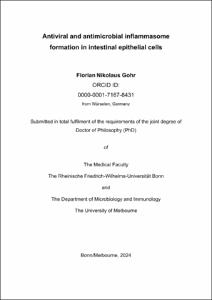Antiviral and antimicrobial inflammasome formation in intestinal epithelial cells

Antiviral and antimicrobial inflammasome formation in intestinal epithelial cells

| dc.contributor.advisor | Schmidt, Florian Ingo | |
| dc.contributor.author | Gohr, Florian Nikolaus | |
| dc.date.accessioned | 2024-08-13T09:16:21Z | |
| dc.date.available | 2025-08-15T22:00:16Z | |
| dc.date.issued | 13.08.2024 | |
| dc.identifier.uri | https://hdl.handle.net/20.500.11811/11824 | |
| dc.description.abstract | Inflammasomes coordinate inflammation by inducing rapid cytokine secretion and protect against invading pathogens by initiating death of infected cells. We developed and characterised a novel fluorescent reporter that visualises inflammasome formation and reports on the recruitment of the effector protein caspase-1 without impairing downstream signalling. Using this reporter, I could demonstrate how caspase-1 is recruited to the inflammasome via the formation of filaments. I additionally show how the CARD-only protein CARD17 inhibits caspase-1 recruitment, and thus cytokine secretion, by terminating caspase-1 filaments. Next, I investigated inflammasome responses in human and mouse intestinal enteroids as models for functional tissues. I found that triggers of the NAIP/NLRC4 inflammasome, including bacteria, activate inflammasomes in mouse enteroids, resulting in cell death and expulsion. However, cells in human enteroids were not able to assemble inflammasomes due to a lack of sensor expression. This implies there may be some differences that exist between the inflammatory response between the mouse and human enteric system, or that some caution and further investigation is required for in vitro analyses with human intestinal enteroids. In response to the emerging coronavirus pandemic, we used our expertise in nanobodies to contribute to the efforts against the disease with new nanobody based research tools and potential therapeutics. We generated nanobodies against the SARS-CoV-2 spike protein and selected four potently neutralizing nanobodies. Combination of two or three nanobodies into multimeric fusions enhanced their activity. I developed a cell fusion assay, where I discovered that some nanobodies neutralize the virus via a novel mechanism, as they prematurely activate the spike protein and convert it to its inactive post-fusion conformation. In summary, I have developed and applied novel research tools to investigate: i) the induction of the inflammasome response in different cellular systems upon different stimuli, and ii) the mechanism of action of SARS-CoV-2 specific neutralizing nanobodies. | en |
| dc.language.iso | eng | |
| dc.rights | In Copyright | |
| dc.rights.uri | http://rightsstatements.org/vocab/InC/1.0/ | |
| dc.subject.ddc | 570 Biowissenschaften, Biologie | |
| dc.title | Antiviral and antimicrobial inflammasome formation in intestinal epithelial cells | |
| dc.type | Dissertation oder Habilitation | |
| dc.identifier.doi | https://doi.org/10.48565/bonndoc-348 | |
| dc.publisher.name | Universitäts- und Landesbibliothek Bonn | |
| dc.publisher.location | Bonn | |
| dc.rights.accessRights | openAccess | |
| dc.identifier.urn | https://nbn-resolving.org/urn:nbn:de:hbz:5-77712 | |
| dc.relation.doi | https://doi.org/10.1126/science.abe6230 | |
| ulbbn.pubtype | Erstveröffentlichung | |
| ulbbnediss.affiliation.name | Rheinische Friedrich-Wilhelms-Universität Bonn | |
| ulbbnediss.affiliation.location | Bonn | |
| ulbbnediss.affiliation.otherLocation1 | Melbourne | |
| ulbbnediss.affiliation.otherName1 | University of Melbourne | |
| ulbbnediss.thesis.level | Dissertation | |
| ulbbnediss.dissID | 7771 | |
| ulbbnediss.date.accepted | 18.07.2024 | |
| ulbbnediss.institute | Medizinische Fakultät / Institute : Institut für Angeborene Immunität | |
| ulbbnediss.fakultaet | Medizinische Fakultät | |
| dc.contributor.coReferee | Mackenzie, Jason | |
| ulbbnediss.contributor.orcid | https://orcid.org/0000-0001-7167-8431 | |
| ulbbnediss.date.embargoEndDate | 15.08.2025 |
Files in this item
This item appears in the following Collection(s)
-
E-Dissertationen (2059)




